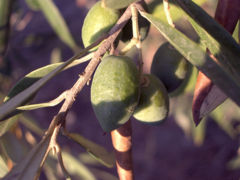Oleaceae: Difference between revisions
No edit summary |
No edit summary |
||
| Line 1: | Line 1: | ||
{{Inc| | |||
Oleaceae (from the genus Olea, derived from the Greek meaning, originally, olive tree, and later oil, i. e., olive oil). Olive Family. Fig. 49. Trees or shrubs: leaves opposite, simple or pinnate: flowers bisexual or unisexual, regular, small and numerous; calyx 4-lobed, rarely 4-15-lobed, valvate; corolla 4-lobed, rarely 6-12-lobed, gamopetalous, rarely polypetalous, or 0, hypogynous, valvate; stamens 2, rarely 3—5, epipetalous, alternate with the corolla-lobes; ovary superior, 2-celled; ovules usually 2 in each cell; style 1 or 0; stigmas 1-2: fruit a drupe, berry, capsule, or samara. | |||
Oleaceae has 20 genera and more than 400 species, of temperate and tropical lands; these are especially abundant in the East Indies and East Asia. About 1O species are native in northeastern North America. Fossil species are known. The family is related to the Loganiaceae; possibly also to the Celastraceae and Rubiaceae. The numerical plan of 4, the 2 stamens and the superior ovary are important distinctive characteristics. | |||
The most useful plant is the olive (Olea europaea) of the Orient, long cultivated in the Mediterranean-region. The oil expressed from the fruit is used as food, and for other purposes. The unripe fruits, preserved in brine, are the olives of commerce. The bark of the fringe tree and privet contains medicinal principles of minor importance, as do also the leaves of the lilac. A saccharine exudation from the bark of Fraxinus Ornus of Sicily, induced by the puncture of a cicada, is manna (See, also, Tamarix mannifera). The wood of olive and ash are valuable. The flowers of Osmanthus fragrans have been used to scent tea in China. | |||
A dozen genera are in cultivation in North America: Chionanthus (Fringe Tree), hardy; Forsythia (Golden Bell), hardy; Fontanesia, hardy; Fraxinus (Ash), hardy: Jasminum (Jasmine, Jessamine), of the greenhouse and the South; Ligustrum (Privet), hardy; Olea (Olive), not hardy; Osmanthus (Fragrant Olive and Devil-1 wood), not hardy; Phillyrea, not hardy; Schrebera, not hardy; and Syringa (Lilac), hardy. | |||
{{SCH}} | |||
}} | |||
{{Taxobox | {{Taxobox | ||
| color = lightgreen | | color = lightgreen | ||
Revision as of 03:38, 13 May 2009
| Standard Cyclopedia of Horticulture |
|---|
|
Oleaceae (from the genus Olea, derived from the Greek meaning, originally, olive tree, and later oil, i. e., olive oil). Olive Family. Fig. 49. Trees or shrubs: leaves opposite, simple or pinnate: flowers bisexual or unisexual, regular, small and numerous; calyx 4-lobed, rarely 4-15-lobed, valvate; corolla 4-lobed, rarely 6-12-lobed, gamopetalous, rarely polypetalous, or 0, hypogynous, valvate; stamens 2, rarely 3—5, epipetalous, alternate with the corolla-lobes; ovary superior, 2-celled; ovules usually 2 in each cell; style 1 or 0; stigmas 1-2: fruit a drupe, berry, capsule, or samara. Oleaceae has 20 genera and more than 400 species, of temperate and tropical lands; these are especially abundant in the East Indies and East Asia. About 1O species are native in northeastern North America. Fossil species are known. The family is related to the Loganiaceae; possibly also to the Celastraceae and Rubiaceae. The numerical plan of 4, the 2 stamens and the superior ovary are important distinctive characteristics. The most useful plant is the olive (Olea europaea) of the Orient, long cultivated in the Mediterranean-region. The oil expressed from the fruit is used as food, and for other purposes. The unripe fruits, preserved in brine, are the olives of commerce. The bark of the fringe tree and privet contains medicinal principles of minor importance, as do also the leaves of the lilac. A saccharine exudation from the bark of Fraxinus Ornus of Sicily, induced by the puncture of a cicada, is manna (See, also, Tamarix mannifera). The wood of olive and ash are valuable. The flowers of Osmanthus fragrans have been used to scent tea in China. A dozen genera are in cultivation in North America: Chionanthus (Fringe Tree), hardy; Forsythia (Golden Bell), hardy; Fontanesia, hardy; Fraxinus (Ash), hardy: Jasminum (Jasmine, Jessamine), of the greenhouse and the South; Ligustrum (Privet), hardy; Olea (Olive), not hardy; Osmanthus (Fragrant Olive and Devil-1 wood), not hardy; Phillyrea, not hardy; Schrebera, not hardy; and Syringa (Lilac), hardy.
|
| Oleaceae {{{status}}} Fossil range: {{{fossil_range}}}
| ||||||||||||||||||||||||||||||||||||||||||||||||||||||||||||||||||
|---|---|---|---|---|---|---|---|---|---|---|---|---|---|---|---|---|---|---|---|---|---|---|---|---|---|---|---|---|---|---|---|---|---|---|---|---|---|---|---|---|---|---|---|---|---|---|---|---|---|---|---|---|---|---|---|---|---|---|---|---|---|---|---|---|---|---|
 Olive (Olea europaea) | ||||||||||||||||||||||||||||||||||||||||||||||||||||||||||||||||||
| Plant Info | ||||||||||||||||||||||||||||||||||||||||||||||||||||||||||||||||||
| ||||||||||||||||||||||||||||||||||||||||||||||||||||||||||||||||||
| Scientific classification | ||||||||||||||||||||||||||||||||||||||||||||||||||||||||||||||||||
| ||||||||||||||||||||||||||||||||||||||||||||||||||||||||||||||||||
| [[{{{diversity_link}}}|Diversity]] | ||||||||||||||||||||||||||||||||||||||||||||||||||||||||||||||||||
| {{{diversity}}} | ||||||||||||||||||||||||||||||||||||||||||||||||||||||||||||||||||
| Binomial name | ||||||||||||||||||||||||||||||||||||||||||||||||||||||||||||||||||
| {{{binomial}}} | ||||||||||||||||||||||||||||||||||||||||||||||||||||||||||||||||||
| Trinomial name | ||||||||||||||||||||||||||||||||||||||||||||||||||||||||||||||||||
| {{{trinomial}}} | ||||||||||||||||||||||||||||||||||||||||||||||||||||||||||||||||||
| Type Species | ||||||||||||||||||||||||||||||||||||||||||||||||||||||||||||||||||
| {{{type_species}}} | ||||||||||||||||||||||||||||||||||||||||||||||||||||||||||||||||||
| Genera | ||||||||||||||||||||||||||||||||||||||||||||||||||||||||||||||||||
| 24 living, 1 recently extinct; see text | ||||||||||||||||||||||||||||||||||||||||||||||||||||||||||||||||||
| [[Image:{{{range_map}}}|{{{range_map_width}}}|]] | ||||||||||||||||||||||||||||||||||||||||||||||||||||||||||||||||||
| Synonyms | ||||||||||||||||||||||||||||||||||||||||||||||||||||||||||||||||||
| {{{synonyms}}} |
Oleaceae, the olives and relatives, is a plant family containing 24 extant genera of woody plants (and one recently extinct), including shrubs, trees and vines. They are characterised by opposite leaves that may be simple or pinnately-compound. The calyx and corolla are four-lobed.
Many members of the family are economically significant. The olive proper (Olea europaea) is extremely important for its fruit and the oil extracted from it. The ashes, genus Fraxinus, are valued for their tough wood, and forsythia, lilacs, jasmines, privets, and fringetrees are all valued as landscaping plants.
Genera
- Abeliophyllum – White Forsythia
- Chionanthus – fringetrees
- Comoranthus
- Dimetra
- Fontanesia
- Forestieria – swamp-privets
- Forsythia – forsythias
- Fraxinus – ash trees
- Haenianthus
- Hesperelaea (extinct)
- Jasminum – jasmines
- Ligustrum – privets
- Menodora
- Myxopyrum
- Nestegis
- Noronhia
- Notelaea
- Nyctanthes
- Olea – olive trees
- Osmanthus – osmanthus
- Phillyrea – mock-privets
- Picconia
- Priogymnanthus
- Schrebera
- Syringa – lilacs